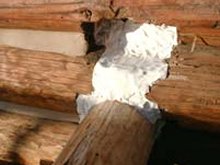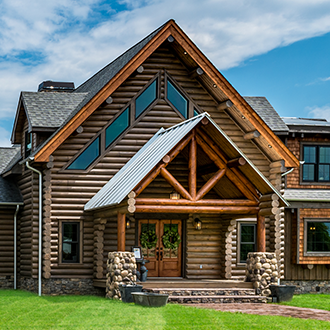It's almost done. Chris will use epoxies to repair log corners.


The next step for Chris is to repair the rotted ends of the logs. This part of the log maintains the greatest chance of becoming damaged and losing structural integrity. The reasons are:
- It's the part of the log that is most likely to be exposed to nature's elements
- It's the part of the log that will always absorb water most easily
- Wood leaving an exposed surface that's been cut against the grain is softer, thus easier to be infested with wood destroying pests.
What Chris will do is "build up" the log using M-Balm, a resin applied to the soft wood to give it a strong, hard foundation to which he will apply E-Wood, a two part putty compound which will be molded into place. Following the curing of E-Wood, he'll have a stainable, lightweight "manufactured" log that is strong enough to hold a nail or screw.


These pictures illustrate how Chris can also use the E-Wood as a form fitting gasket into which he will place a perpendicular log to achieve a weather-tight seal, or simply to fill in a large void.
Move to: Week 1, Week 2, Week 3, Week 4, Week 5, Week 7, or return to 2. Restore









 In 1981 Perma-Chink Systems (PCS) introduced flexible chinking to the log home industry to replace what was the standard at the time - concrete mortar. This revolutionary product, Perma-Chink Log Home Chinking, looked like authentic mortar but stretched and flexed to accommodate log movement while maintaining a tight seal for the life of the house.
In 1981 Perma-Chink Systems (PCS) introduced flexible chinking to the log home industry to replace what was the standard at the time - concrete mortar. This revolutionary product, Perma-Chink Log Home Chinking, looked like authentic mortar but stretched and flexed to accommodate log movement while maintaining a tight seal for the life of the house.






